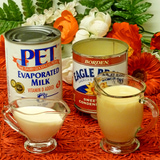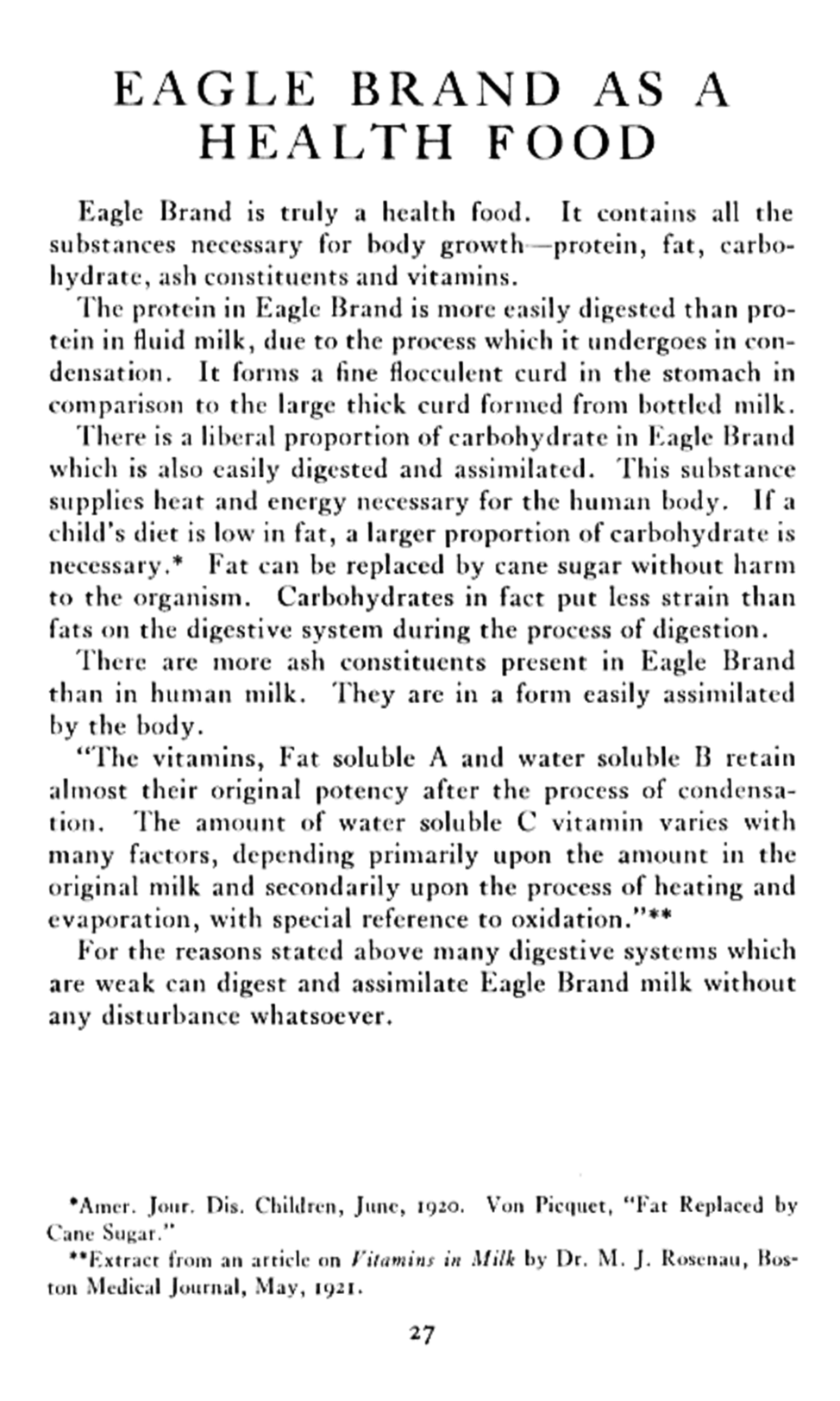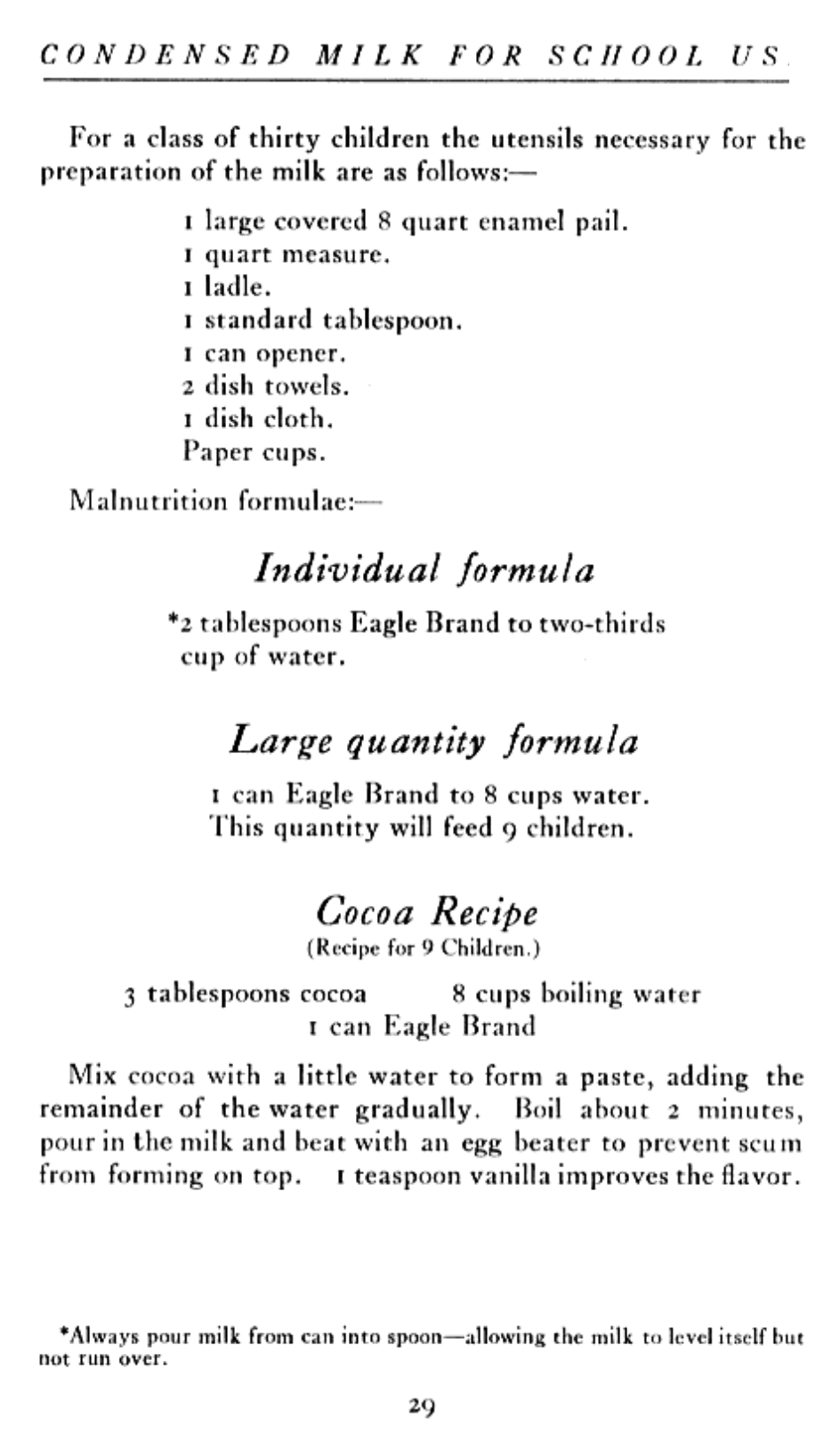This file downloaded on July 6, 2013 from three linked web sites:
homecooking.about.com/od/milkproducts/a/canmilkhistory.htm,
homecooking.about.com/od/cookingfaqs/f/faqcannedmilk.htm,
www.milk.com/wall-o-shame/nutrition/Condensed_Milk.html
Canned Milk History - Evaporated and Sweetened Condensed Milk
Early canned milk was safer than fresh milk
By Peggy Trowbridge Filippone
2010 Peggy Trowbridge Filippone, licensed to About.com, Inc.
 Depending on your age and perhaps gender, you may have never partaken of evaporated or condensed milk, at least not knowingly. Chances are your grandmother or great-grandmother made at least one heirloom comfort food using one or the other. In the early part of the 1900s, both were used more than fresh milk because they were more shelf-stable and posed less of a health risk than fresh milk. Of course, this was before the government had laws in effect to insure the safety of fresh milk, not to mention refrigerators as standard equipment in every kitchen. Those in the armed forces are familiar with both of these milk staples. Today, low-fat, skim and non-fat versions are available with recipe applications not limited to sweets and desserts. Learn more about evaporated and condensed milk before trying the canned milk recipes.
Depending on your age and perhaps gender, you may have never partaken of evaporated or condensed milk, at least not knowingly. Chances are your grandmother or great-grandmother made at least one heirloom comfort food using one or the other. In the early part of the 1900s, both were used more than fresh milk because they were more shelf-stable and posed less of a health risk than fresh milk. Of course, this was before the government had laws in effect to insure the safety of fresh milk, not to mention refrigerators as standard equipment in every kitchen. Those in the armed forces are familiar with both of these milk staples. Today, low-fat, skim and non-fat versions are available with recipe applications not limited to sweets and desserts. Learn more about evaporated and condensed milk before trying the canned milk recipes.
Canned milk history
Prior to the nineteenth century, drinking milk was an iffy situation with regard to health risks. Milk straight from the cow was loaded with bacteria. Milk not consumed within a matter of hours in summer soon spoiled in the heat. Illness allegedly derived from contaminated milk consumption was referred to as "the milksick," "milk poison," "the slows," "the trembles," and "the milk evil." Granted some of these illnesses (considering modern-day knowledge of lactose intolerance) were probably not due to the milk or milk alone, but the stigma persisted.
The idea for a portable canned milk product that would not spoil came to Gail Borden during a transatlantic trip on board a ship in 1852. The cows in the hold became too seasick to be milked during the long trip, and an immigrant infant died from lack of milk. Borden realized his goal in 1854. His first condensed milk product lasted three days without souring. He first thought the condensing process of the milk made it more stable but later on realized it was the heating process that killed the bacteria and microorganisms that cause spoilage.
Borden was granted a patent for sweetened condensed milk in 1856. The sugar was added to inhibit bacterial growth. Skim milk devoid of all fat was used. Use of this early version lacking in nutrients as a mainstay for young working-class children has been blamed for contributing to a rash of rickets cases in 1905. The Borden Company issued this press release in 1924, extolling the virtues of its product "in relief work among war refugees and in the treatment of public school children of New York".
Early canned milk was spurned
Borden's new condensed milk product was not well-received in its early days. In those days, customers were used to watered-down milk, with chalk added to make it white and molasses added for creaminess. Borden had begun commercial production in 1857 in Burrville, Connecticut. When the dubious practice of feeding New York cows on distillery mash by competing fresh milk suppliers was exposed by Leslie's Illustrated Newspaper, Borden's condensed milk business greatly benefited. In 1861, the Union Army purchased Borden's condensed milk for use in field rations, further bolstering its success.
It was John Baptist Meyenberg who first suggested canned evaporated milk to his employers at the Anglo-Swiss Condensed Milk Co. in Switzerland in 1866. Since the company was already so successful producing sweetened condensed milk, the idea was rejected. Meyenberg emigrated to the United States and began his own company, Helvetia Milk Condensing Co. (Pet Milk), eventually marketing unsweetened condensed milk in 1890.
Although Borden received his patent in 1854, unsweetened condensed milk was not successfully canned until 1885 by competitor John Meyenberg. Borden added evaporated milk to the product line in 1892. In 1899, Elbridge Amos Stuart came up with a new process for canned, sterilized, evaporated milk. With help from evaporated milk pioneer Meyenberg, Stuart began successful mass production of canned evaporated milk. Evaporated milk manufacturers pioneered the use of homogenization (redistribution of fat globules so they are imperceptibly distributed), but dairies producing fresh milk were slow to follow the homogenization trail.
With all the talk these days of irradiating foods to eliminate microorganisms that cause foodborne illness, you may think it a relatively new procedure. Not at all. In 1934, Pet Milk Co. introduced the first evaporated milk products to be fortified with vitamin D via irradiation processing. Nowadays, less than two percent of the United States milk production is evaporated or condensed.
homecooking.about.com/od/cookingfaqs/f/faqcannedmilk.htm
More About Evaporated and Condensed Milk plus Recipes
What is the difference between evaporated and sweetened condensed milk?
Question: What is the difference between evaporated and sweetened condensed milk?
In the early part of the 1900s, both evaporated and sweetened condensed milk were used more than fresh milk because they were more shelf-stable and posed less of a health risk than fresh milk. The two are quite different and using the wrong one can ruin your recipe.
Answer:
What is evaporated milk?
As its moniker explains, evaporated milk is milk which has had about sixty percent of the water removed via evaporation. It is then homogenized, rapidly chilled, fortified with vitamins and stabilizers, packaged, and finally sterilized. Standards require whole evaporated milk contain at least 7.9 percent milk fat and 25.5 percent milk solids. The high heat process gives it a bit of a caramelized flavor, and it is slightly darker in color than fresh milk. The evaporation process naturally concentrates the nutrients and the calories, so evaporated versions are more calorie-laden and nutritious than their fresh counterparts. You'll find skim, low-fat and whole milk varieties of evaporated milk. Low-fat and skim versions are also required to have added vitamin A, while all have added vitamins D and C.
What is sweetened condensed milk?
Sweetened condensed milk goes through less processing than evaporated milk. Sixty percent of the water has also been removed from condensed milk, but it differs in that sugar has been added. Condensed milk contains 40 to 45 percent sugar, at least 8 percent fat and 28 percent milk solids. Condensed milk is pasteurized during the evaporation procedure, with the added sugar making any further sterilization unnecessary, since the sugar inhibits the growth of microorganisms. Governmental regulations require that vitamin A be added to condensed milk, but no other nutrients are required by law although they may be added. Condensed milk is very high in calories.
Unsweetened condensed milk is a redundant term. It is simply evaporated milk.
When mixed with an acidic ingredient, sweetened condensed milk thickens naturally without requiring heat. It is perfectly suited for puddings, pie fillings, bar cookies and refrigerated desserts. Condensed milk comes in regular, low-fat, fat-free, and even chocolate varieties.
You will readily notice that sweetened condensed milk is darker, more yellow in color as well as being extremely thick like molasses. Evaporated milk is slightly darker in color than whole milk, but pours the same.
Press release: Condensed Milk
(scanned copies of original followed by typed version)





CONDENSED MILK
These various experiences in dealing with malnutrition all have one essential feature in common--the use of condensed milk. This food proved equally valuable in relief work among war refugees and in the treatment of public school children of New York.
What is Condensed Milk?
Borden's Eagle Brand Condensed Milk is pure cow's milk properly combined with unadulterated cane sugar.
The milk which is used in Eagle Brand is fresh, pure, full cream milk from healthy cows. The cows are examined and the dairies carefully inspected at regular intervals. The condensaries are located near the dairies, which makes it possible to receive the raw milk in a perfectly fresh state. The laboratory system maintained by the Borden Company insures milk of an even higher quality than that required under the government pure food laws. From each can of pure raw milk delivered to the plants, a sample is taken and immediately tested by experts to detect the slightest deviation from the required standards.
The milk, having passed the inspectors at the condensary, is put into heating-wells where it is subjected to a temperature of about 206 degrees Fahrenheit by passing a jet of live steam through it. This degree of heat is held for about five minutes in the heating wells. The milk is then passed on to sugar wells where it is mixed with pure sugar which is added for the purpose of preserving. This mixture is then run into vacuum pans where it is held at a temperature of not more than 140 degrees Fahrenheit for a period of from 1 to 1 1/2 hours, the temperature being gradually lowered until the batch is finished. By this process the growth-promoting properties of the milk are not lost, and the fresh milk and pure sugar are properly blended. The finished product is run through the cooling system, and then into the standard size cans as sold in stores. From the time the milk passes into the vacuum pan until it is sealed in the can every possible precaution is used to prevent contamination and oxidation.
To further insure the quality of this health food, sample cans of Eagle Brand Milk are taken from each batch and incubated for one week, or longer, at our home office laboratory, to determine whether there has been any bacterial growth since the first test made at the plant immediately after condensing. This final test is a check on all previous tests. Milk-born epidemics have never been traced in any way to Borden's Eagle Brand Condensed Milk. It is an absolutely safe milk supply. Clean milk kept clean--is the Borden Ideal.
How to Care for Eagle Brand After Opening Can
It is safe to leave the milk in the original can. If you empty the can into some other container you must admit that it would be a great risk unless you feel sure that the container was as clean as the original can. The tin does not injure the quality of the milk after the can has been opened and exposed to the air. It is however, unsanitary and dangerous to expose any food, because of the dust, flies, etc., which carry disease germs, and even though you keep the opened can of Eagle Brand in a cupboard or ice box, we recommend that you cover the can tightly with an inverted cup or tumbler. By these means the contents of the opened cans will remain wholesome for a longer period than ordinarily would be taken for consumption.
EAGLE BRAND AS A HEALTH FOOD
Eagle Brand is truly a health food. It contains all the substances necessary for body growth--protein, fat, carbohydrate, ash constituents and vitamins.
The protein in Eagle Brand is more easily digested than protein in fluid milk, due to the process which it undergoes in condensation. It forms a fine flocculent curd in the stomach in comparison to the large thick curd formed from bottled milk.
There is a liberal proportion of carbohydrate in Eagle Brand which is also easily digested and assimilated. This substance supplies heat and energy necessary for the human body. If a child's diet is low in fat, a larger proportion of carbohydrate is necessary.* Fat can be replaced by cane sugar without harm to the organism. Carbohydrates in fact put less strain than fats on the digestive system during the process of digestion.
There are more ash constituents present in Eagle Brand than in human milk. They are in a form easily assimilated by the body.
``The vitamins, Fat soluble A and water soluble B retain almost their original potency after the process of condensation. The amount of water soluble C vitamin varies with many factors, depending primarily upon the amount in the original milk and secondarily upon the process of heating and evaporation, with special reference to oxidation.''**
For the reasons stated above many digestive systems which are weak can digest and assimilate Eagle Brand milk without any disturbance whatsoever.
* Amer. Jour. Dis. Children, June, 1920. Von Picquet, ``Fat Replaced by Cane Sugar.''
** Extract from an article on Vitamins in Milk by Dr. M. J. Rosenau, Boston Medical Journal, May, 1921.
CONDENSED MILK FOR SCHOOL USE
The importance of the teachers' position in overcoming malnutrition has already been described and the definite suggestion made that they start health and nutrition work among their classes. An essential feature of such a program is the regular addition of Borden's Eagle Brand Condensed Milk to the children's daily diet.
The first question is:--``Why should condensed milk be used for the malnourished child?''
1. With the proper dilution and administration, Eagle Brand will meet every essential need as a milk food.
2. It can be definitely depended upon as being absolutely free from harmful bacteria. (One can never be too careful regarding the cleanliness of milk. Know the source of your milk supply.)
3. It is decidedly economical.
4. It keeps perfectly and is most convenient in actual use.
The next question is:--How can the teacher introduce the use of condensed milk into the regular school program?
This can generally be arranged with little difficulty. The head of the school, moreover, is usually glad enough to cooperate in such a plan. In many schools there is already some provision made for serving children milk between meals. Eagle Brand is not only less expensive than pasteurized bottled milk but is far easier to buy and keep on hand for school use.
About 10 o'clock, or the middle of the forenoon session, is the best time for the school feeding. Many teachers have the mid-morning feeding at the recess period or during brief rest periods between classes, in order not to disrupt the regular school program.
The preparation of this health food is very simple. The utensils and the cans of milk can be kept with the classroom equipment. Some of the older girls can be assigned to take charge of the mixing of the milk and thus relieve the teacher of the details.
For a class of thirty children the utensils necessary for the preparation of the milk are as follows:--
1 large covered 8 quart enamel pail.
1 quart measure.
1 ladle.
1 standard tablespoon.
1 can opener.
2 dish towels.
1 dish cloth.
Paper cups.
Malnutrition formulae:--
Individual formula
*2 tablespoons Eagle Brand to two-thirds cup of water.
Large quantity formula
1 can Eagle Brand to 8 cups water.
This quantity will feed 9 children.
Cocoa Recipe
(Recipe for 9 Children.)
3 tablespoons cocoa 8 cups boiling water 1 can Eagle Brand
Mix cocoa with a little water to form a paste, adding the remainder of the water gradually. Boil about 2 minutes, pour in the milk and beat with an egg beater to prevent scum from forming on top. 1 teaspoon vanilla improves the flavor.
* Always pour milk from can into spoon--allowing the milk to level itself but not run over.